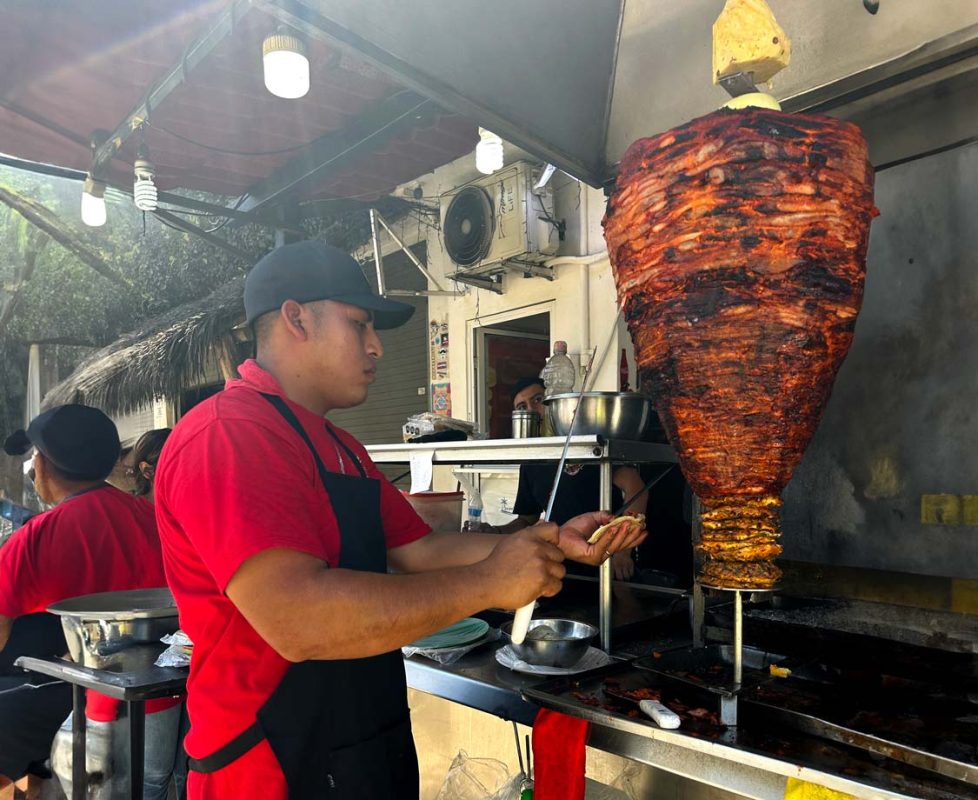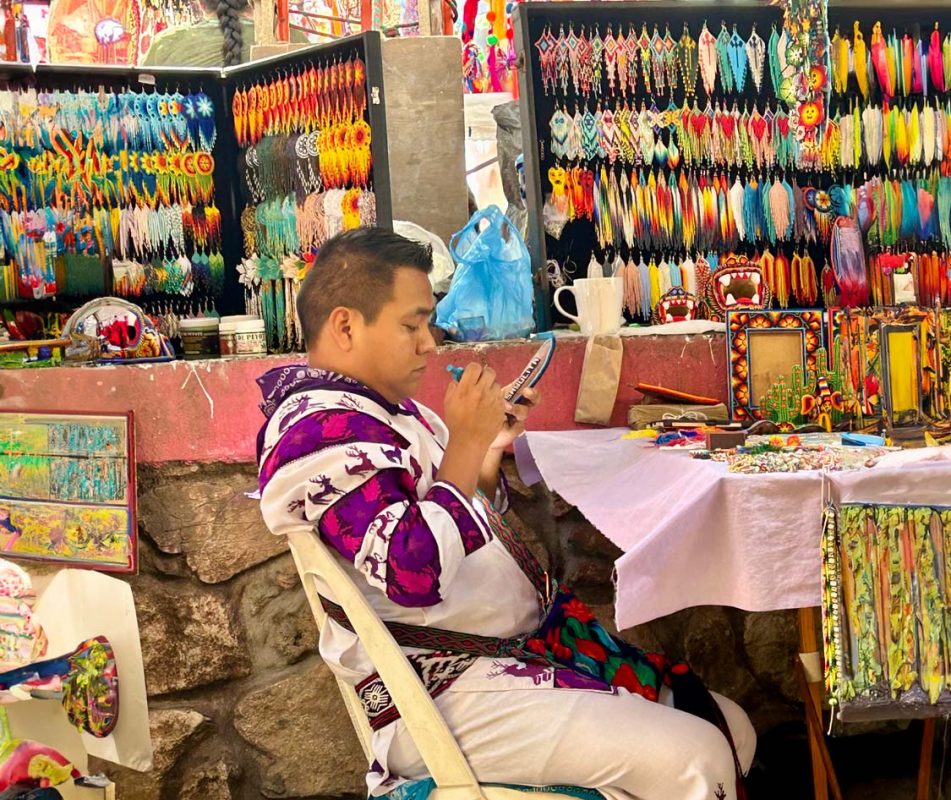Dive into the delicious side of Sayulita on a tantalizing food tour! Savor authentic Mexican flavors beyond tacos, explore hidden gems, and unlock the secrets of Sayulita’s cuisine with local experts. Indulge your senses and experience the true taste of Sayulita!

Two women pose next to a city sign on a Sayulita Mexico food tour
Sayulita, on Mexico’s Pacific coast, started out as a surfer/hippy hangout and has evolved into a bustling community that now attracts surfers, artists, and a slew of young entrepreneurial chefs. The boho-chic vibe is a perfect breeding ground for one of the country’s most vibrant dining and cocktail scenes.
In the past few years, I’ve enjoyed several foodie experiences in Puerto Vallarta, such as taco crawls and the hip, up-and-coming Versalles neighborhood with Vallarta Food Tours in Puerto Vallarta.
When planning for a recent trip down south, I noticed they had added Sayulita (about 45 minutes north of Puerto Vallarta) to their food tour roster. My husband and I decided to pack our appetites and sign up. We met in central Puerto Vallarta, where Chris, our guide, was waiting with two other couples and a van stocked with cold cervezas and bottled water.

Sayulita Beach
Sayulita is known as the surf capital of Riviera Nayarit because the waves here are consistent year-round. Several companies offer lessons for beginners, and it’s also the site of various international surfing tournaments.
As surfers and hippies flocked to this idyllic little town, tucked between the rolling waves and Sierra Madre Occidental Mountains, galleries filled with the works of local artisans, funky fashion boutiques, weekly markets, yoga studios and all sorts of eateries began to appear.
In 2015, the tourism branch of the Mexican government designated Sayulita as a “Pueblo Magico” (magical town) because it maintains traditional culture, history, nature and cuisine. It’s one of just 177 Magic Towns in all of Mexico.
A Culinary & Drink Tour of Sayulita
Roadside Attraction

Roadside fruit stand near Sayulita, Mexico
The first stop for our group was a roadside stand on Highway 200, about 10 minutes south of the Sayulita turn-off. Here, the owner and his family proudly introduced us to many of the local exotic fruits—mangos, jackfruit, tiny pineapples, bananas, tamarind, and passionfruit.
The family makes a delicious variety of dried snacks and candies using these fruits, often spiking them with chilli pepper, wonderful for those who love a little extra “zing” in their food.
We were offered lots of samples and had time to buy some souvenirs.
Hippy Margaritas and Agave 101

Holding a bottle of Cascahuin tequila at Kahlo restaurant in Sayulita
Our first tour stop in Sayulita was at Kahlo Restaurant and Bar (Avenida Revolución 39), named in honor of Mexico’s famous artist and femme fatale, Frida Kahlo.
Ivan, the gregarious owner, had a table waiting for us, and soon, we were each tucking into a smoked brisket taco with a “hippy margarita” which had been set in front of us. Chris gave us a brief lesson on the agave plant, explaining that all tequila must be made from the blue agave cactus grown only in the State of Jalisco.
Mezcal, a drink that is becoming increasingly popular with the cocktail crowd, is usually made from green espadin agave and takes on a smoky flavor because the agave husk is slowly smoked in a pit. Pulque is an ancient pre-Hispanic drink made from agave that is fermented, not distilled.
Think Mexican kombucha!
Kahlo’s Hippy Margarita combines ginger, Cascahuin blanco tequila, Cointreau, cardamon syrup and lime. The glass was rimmed with salt that had been ground with hibiscus flowers in a molcajete (pestle made from volcanic rock).
The slow-cooked beef brisket taco garnished with pickled red onion, creamy avocado, and fresh coriander sprigs and presented with a trio of salsas (mild, hot, and watch out!) was the perfect pairing.
Tacos al Pastor Could be Mexico’s Unofficial National Dish

A chef at Tacos al Pastor Talivan prepares his famous dish
We strolled past the busy town square festooned overhead with colorful banners and headed next to Tacos Al Pastor Talivan (Avenida Revolución 26).
Tacos al pastor, or shepherd-style tacos, explained Chris, were introduced to Mexico by Lebanese immigrants in the 1930s as an alternative to lamb shawarma.
But lamb is not a popular meat in Mexico, so they substituted pork, which is marinated for several hours with orange juice, spices, and chilies, such as guajillo, achiote, or adobo, and then cooked on a rotating vertical spit over a fire of hot coals.
A whole peeled pineapple on top drips down during the cooking process to impart a sweet and tangy contrast to the succulent, savory pork. Our tacos were served promptly on a plate covered with a plastic bag. Chris explained that this is the fastest and sanitary way to serve a lot of customers at busy taco joints all over Mexico, where dishwashing facilities might be limited.
Tacos al pastor is arguably the most popular kind of portable meal in all of Mexico. They could be Mexico’s unofficial national dish. You can find our authentic tacos al pastor recipe here.
Calling all Carnivores

Chili poblano taco at El Itacate at El Itacate Restaurant
Chris wanted to be sure we arrived at El Itacate (Avenida Revolucion 15), which roughly translated means the doggy bag) before the lunchtime rush.
Billing itself as “los tacos mas chidaos en Sayulita” (the coolest tacos in town), El Itacate has a loyal following. They dish out either corn or flour tortillas heaped with generous servings of high-quality rib eye, arrachera, sirloin, and other beefy delights, as well as a great selection of vegetarian, fish, pork, and chicken tacos.
I opted for the chili poblano stuffed with shrimp, and my husband decided to try the freshly caught grilled octopus. Garnishes included habanera-marinated onions, stewed beans, pico de gallo, avocado cream, and two chili salsas. A margarita muddled with fresh hibiscus petals and strawberries rounded out our moveable feast.
A Little Free Time In Sayulita

A Huichol craftsman creates beadwork
Chris suggested a stroll over the bridge to browse the souvenir market, followed by a gelato stop at Buonissimo Cafe (Manuel N. Navarrete 55). I could not resist a scoop of passionfruit and one of Ferrero Rocher.
Before returning to our van, our group had an hour of free time to wander.
The beach, as always, was full of sunbathers, vendors hawking trinkets, massage tables under tents, and a show of surfers. I headed back to the town center where ChocoBanana, a Sayulita institution, sits just a few doors down from the church. Its claim to fame is the frozen banana dipped in chocolate and granola. I munched on my banana “popsicle” and watched the Huichol craftsmen painstakingly making their intricate bead jewelry.
When the Spanish conquistadors arrived in what is now Mexico in the 16th century, the Huichol aboriginals (also known as the Peyote People) fled to the Sierra Madre Mountains, where they were able to retain their customs, which included the ceremonial use of peyote. Their hallucinogenic visions inspired their psychedelic art, which comes in the form of intricately beaded masks, animals, bowls, bracelets, and more. I purchased a beaded bracelet, a fond memory of Sayulita.
Vallarta Food Tour’s mission is to seek out off-the-beaten-path food and drinks and provide local insight into the culture and traditions of their tour destinations. What sets the company apart from the competition is their team of guides who are passionate about sharing an authentic, delicious slice of life in this region.
Their guides are accredited Federal Tour Guides who have successfully passed classes on the history of Mexico and its culture. I always eat and drink well on these tours, but I also never fail to learn some interesting tidbits about Mexico’s rich culinary traditions and fascinating culture.
Taco/Tequila Trivia
It is believed that the word “tacos” began with Mexican silver miners in the 18th century. They wrapped gunpowder in paper “taquitos” and inserted them into rocks to detonate. Similarly, food wrapped in a corn tortilla was an easy portable meal for the working class and was known as miner’s tacos.
The dish was cheap and delicious…and could be as explosively hot as dynamite! Eventually, in the early 1900s, Mexican migrants came to the United States to work on railroads and other jobs, and they brought tacos with them. The spicy Mexican ingredients started to fuse with milder American fare, including lettuce, grated cheese, and sour cream, to cool things off.
Tips For Your Experiencing Your Own Sayulita Food Tour
Tacos star in their own TV show called the “Taco Chronicles.” You can watch it on Netflix in Spanish with English subtitles. In series one, the mouth-watering series covers the various kinds of tacos in regions throughout Mexico with interviews with the cooks and farmers. The second series takes place in the United States. Warning: you’ll be tempted to jump on the next plane to get your taco fix!
There’s a worm in my tequila!
No, there isn’t. Only some mezcal (never tequila) has a worm in the bottle. These are actually not worms but moth larvae that feed off the maguey agave plant used to make mezcal.
Some speculate that the “worm in the bottle” was a marketing ploy to entice people to drink mezcal instead of tequila. Supposedly, the dead worm indicated that the booze was sufficiently potent to kill it. But steer clear of such gimmicks. The best mezcal is larvae-free.



